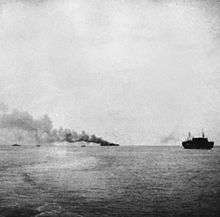18th Infantry Division (United Kingdom)
| 18th Infantry Division | |
|---|---|
 18th Infantry Division badge | |
| Active | 1939-1942 |
| Country |
|
| Branch |
|
| Type | Infantry |
| Size | Division |
| Engagements |
Battle of Muar (53rd Infantry Brigade) Singapore (1942) |
| Commanders | |
| Notable commanders | Major-General Bernard Paget |
The 18th Infantry Division was an infantry division of the Territorial Army, part of the British Army, that saw service in World War II. It was formed as a 2nd Line duplicate of the 54th (East Anglian) Infantry Division using mostly units with connections to East Anglia. The division fought in the short but violent Battle of Singapore but later surrendered and was captured by the Imperial Japanese Army in February 1942.
History
Throughout the spring and summer of 1939 the Territorial Army was ordered to be doubled in size, due to the increasing likelihood of a war in Europe with Nazi Germany. The 54th (East Anglian) Infantry Division, a 1st Line division, formed a duplicate unit, to be known as the 18th Infantry Division. The 18th Division, however, was not formed as an exact mirror duplicate as most divisions were and was instead divided on geographical basis. The 4th, 5th, 6th and 7th battalions of the Royal Norfolk Regiment, the 4th and 5th Suffolk Regiment and the 1st and 2nd Cambridgeshire Regiment were all assigned to 18th Division, with the 1/4th, 1/5th, 2/4th and 2/5th battalions of the Essex Regiment, the 6th Bedfordshire and Hertfordshire Regiment and both the 1st and 2nd Hertfordshire Regiment were assigned to 54th Division.[1]
Among the infantry brigades, the 53rd Infantry Brigade was converted (simply redesignated) from the 163rd Infantry Brigade, originally part of the 54th (East Anglian) Division, on 18 September 1939.
In October 1941 the 18th Division was preparing to move overseas and left the United Kingdom on 28 October, originally intending to be sent to the Middle East but, after the Japanese entered the war, was diverted to the Far East instead and was sent to Singapore. The 53rd Brigade arrived there on 13 January 1942, before the rest of the division, and was attached to the 11th Indian Infantry Division and Westforce on mainland Malaya where it was involved in the retreat back to Singapore, fighting the Battle of Muar, the last major battle of the Malayan Campaign, in company with Indian units.
The main part of the 18th Division landed at Singapore a few weeks before the fall of the island. After the violent week-long Battle of Singapore, Lieutenant-General Arthur Ernest Percival, commander of the Singapore garrison, surrendered to the Imperial Japanese Army on 15 February 1942. The division's soldiers went into Japanese Prisoner of war camps where they suffered many hardships for the next three years.
The 18th Division was not reformed later in the war or afterwards when the Territorial Army was reformed in 1947.
Order of Battle

The 18th Infantry Division was constituted as follows during the war:
- 5th Battalion, Royal Norfolk Regiment
- 6th Battalion, Royal Norfolk Regiment[2]
- 7th Battalion, Royal Norfolk Regiment (left 1 November 1939)
- 2nd Battalion, Cambridgeshire Regiment (from 1 November 1939)[3]
- 53rd Infantry Brigade Anti-Tank Company (formed 23 September, disbanded 14 December 1940)
- 4th Battalion, Royal Norfolk Regiment
- 4th Battalion, Suffolk Regiment
- 5th Battalion, Suffolk Regiment
- 54th Infantry Brigade Anti-Tank Company (formed 7 October , disbanded 14 December 1940)
- 5th Battalion, Bedfordshire and Hertfordshire Regiment
- 1st Battalion, Cambridgeshire Regiment[4]
- 2nd Battalion, Cambridgeshire Regiment (left 30 October 1939)
- 1/5th Battalion, Sherwood Foresters (from 8 July 1940)[5]
- 55th Infantry Brigade Anti-Tank Company (formed 9 September, disbanded 14 December 1940)
Divisional Troops
- 9th Battalion, Royal Northumberland Fusiliers, (Machine Gun Battalion, joined shortly before leaving United Kingdom)[6] [7]
- 5th Battalion, Loyal Regiment (North Lancashire) (Motorcycle Battalion, joined 13 January 1941, on 25 April 1941 became 18th Battalion, Reconnaissance Corps
- 105th (Bedfordshire Yeomanry) Field Regiment, Royal Artillery (left 11 November 1939)
- 118th (8th London) Field Regiment, Royal Artillery (from 30 June 1940)
- 135th (East Anglian) (Hertfordshire Yeomanry) Field Regiment, Royal Artillery
- 148th (Bedfordshire Yeomanry) Field Regiment, Royal Artillery
- 65th (Norfolk Yeomanry) Anti-Tank Regiment, Royal Artillery (left 19 December 1939)
- 125th (Northumbrian) Anti Tank Regiment, Royal Artillery (from 4 July 1940)
- 287th Field Company, Royal Engineers
- 288th Field Company, Royal Engineers
- 560th Field Company, Royal Engineers (from 15 December 1939)
- 251st (East Anglian) Field Park Company, Royal Engineers
- 18th Divisional Signals Regiment, Royal Corps of Signals
Commanders
- 30.09.1939 Major-General T.G. McArthur
- 30.11.1939 Major-General Bernard Charles Tolver Paget
- 20.04.1940 (Acting) Major-General Edward Backhouse
- 14.05.1940 Major-General Bernard Charles Tolver Paget
- 27.05.1940 (Acting) Brigadier G. E. W. Franklyn
- 01.06.1940 Major-General. T. R. Eastwood
- 09.06.1940 Major-General L. H. K. Finch
- 14-07-1940 Major-General Merton Beckwith-Smith (P.O.W 15.02.1942)
See also
References
- ↑ http://www.britishmilitaryhistory.co.uk/webeasycms/hold/uploads/bmh_document_pdf/18_Infantry_Division__1939_.pdf
- ↑ Commanded at Singapore by Lieutenant Colonel Ian Lywood who was hospitalised with malaria but killed during the massacre at Alexandra Hospital.
- ↑ At the time commanded by Lieutenant Colonel Thorne.
- ↑ Lieutenant Colonel Gerald Carpenter commanded the battalion when Singapore fell.
- ↑ Lieutenant Colonel Harold Lilly commanded the battalion at Singapore.
- ↑ http://www.britishmilitaryhistory.co.uk/webeasycms/hold/uploads/bmh_document_pdf/18_Infantry_Division__1942_.pdf
- ↑ Commanded at Singapore by Lieutenant Colonel Lechmere Thomas/Henry (Flossie) Flower
- 'Singapore Burning', Colin Smith. Penguin Books 2006. England. ISBN 978-0-14-101036-6
External links
- Order of Battle
- Unit History
- Order of Battle Data Base
- Cambridgeshire Regt. Site
- History of Malayan Campaign